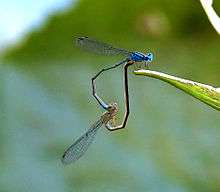Blue riverdamsel
| Blue riverdamsel | |
|---|---|
 | |
| Male blue riverdamsel | |
| Scientific classification | |
| Kingdom: | Animalia |
| Phylum: | Arthropoda |
| Class: | Insecta |
| Order: | Odonata |
| Suborder: | Zygoptera |
| Family: | Coenagrionidae |
| Genus: | Pseudagrion |
| Species: | Pseudagrion microcephalum |
| Binomial name | |
| Pseudagrion microcephalum (Rambur, 1842) | |
The blue riverdamsel is a common species damselflies in the Coenagrionidae family.[1] It is also known as the blue sprite. They grow to 38mm in length. This species can easily be found near running water or still water. They usually rest on the plants either in the middle of ponds or at the water edges. On a sunny winter day, this damselfly may be the only damselfly still flying over the water, even though few of them can be seen. In the summer, a large number of blue riverdamsels are competing for a good perching position with other damselflies. The male of this damselfly is brightly blue in colour with black pattern on his abdomen. Its head, face, and eyes are also blue. Pseudagrion microcephalum looks similar to the common bluetail and the eastern billabongfly. The female is blue-grey to grey-green in colour.[2]
Mating and reproduction
Blue riverdamsels mate in tandem position. After mating is done the female will return to the water and lay her eggs, usually with the male still in the tandem position. They lay their eggs in the plants under the surface of water. Females have a blade-like ovipositor for making an opening in the plant for her eggs. They will sometimes lay eggs alone without the male in tandem position.
Distribution
This species can be found in the Australian states of New South Wales, Northern Territory, Queensland, Victoria and Western Australia. It can also be found in Asia:Bangladesh, China, Guangxi, Hong Kong, Hainan, Indonesia, India, Japan, Sri Lanka, Myanmar, Malaysia, Philippines, Peninsular Malaysia, Singapore, Thailand, Taiwan, and Viet Nam.[3]

References
- ↑ Blue riverdamsel - Pseudagrion microcephalum
- ↑ Theischinger, G; Hawking, J (2006). The Complete Field Guide to Dragonflies of Australia. Collingwood Vic.: CSIRO Publishing. p. 84. ISBN 978 0 64309 073 6.
- ↑ Australian Faunal Directory